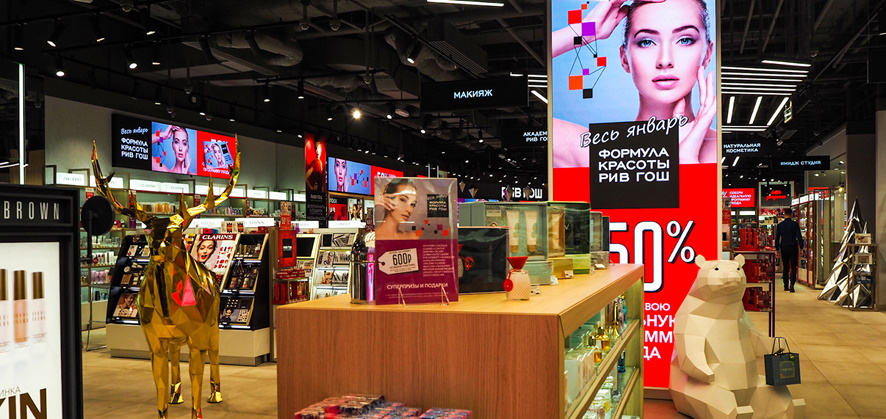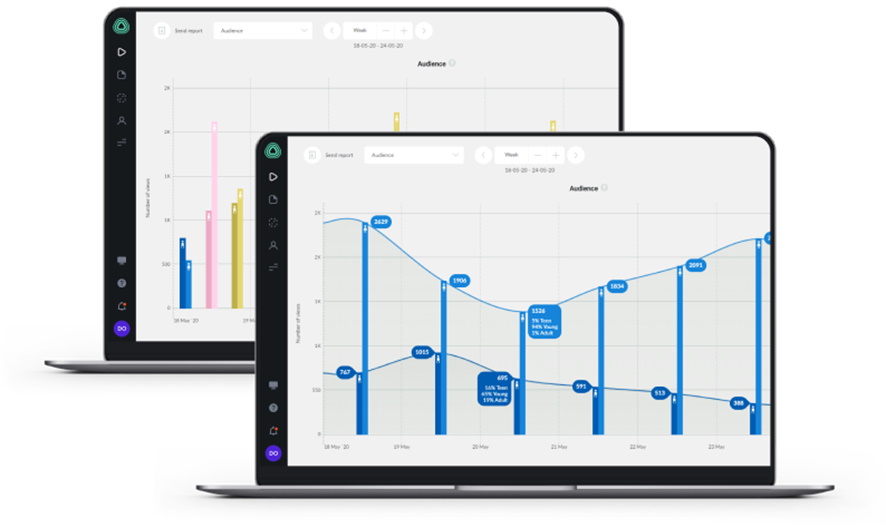
Hello, Habr! My name is Sergey Galeev, I am the CEO of Addreality. We are engaged in audio and video communication personalization projects at points of sale, on the street and in transport. Our work is directly related to video analytics, BigData and personalization.
Today, together with our CTO, Alexey Rekish, we will talk about how targeting and understanding of reach for communication using digital screens, DOOH (digital out of home), works.
Why all this? If you remember, in the world of the future films "Minority Report" or "Blade Runner", people passing by video screens or holograms on the street were shown personalized information. Each person was shown exactly what could be useful to him. True, in the film, the retina was scanned for this, which, fortunately, is prohibited in our reality. Nevertheless, personalized communication with a potential buyer is an essential part of a business, and over time the relevance of such a method will grow. The future, in general, has already arrived, and in this article I want to talk about the nuances of this communication channel.
Some general information about DOOH
Digital outdoor advertising has two main formats:

Outdoor, in fact, outdoor format. This is all that can be seen on the street: billboards on the walls of buildings, windows, plus advertising on transport, facing the street.

Indoor - "outdoor indoor" format. This is digital advertising, which is located inside buildings and inside vehicles, which is commonly called transit media.
Companies, large and small, actively use DOOH in their work. For example, bike rental operator Santander used a contextual digital external marketing campaign to talk about their services. The screens displayed banners with the nearest parking lots, as well as information on the number of free bicycles.
The carrier Heathrow Express has posted welcome stories on screens near the baggage carousels. Greetings were created on the fly in different languages. To do this, we used flight arrival data. Digital screens offered weather-appropriate ways to spend time in London.
In general, DOOH requires a large amount of data for normal operation and, preferably, arriving in real time. But WiFi analytics is increasingly becoming a thing of the past due to problems of randomization (automatic spoofing of MAC addresses) and the legal side of obtaining this data. At the same time, the trend of using anonymized GEO data from LBS (Location Based Services) is developing globally. Example TAP TAP or services from Mobile providers.
Indoor and inside transport still uses WiFi analytics, which is supplemented by video analytics and data obtained from the location itself. For example, in retail - data from cash registers without personal data, from visitor counters or information from loyalty systems, where Bluetooth beacons technology helps to collect a portrait of the audience, for example iBeacon.
Already existing IT services provide a large number of opportunities for optimizing the efficiency of communication, since they collect impersonal data on the audience, the attention of passers-by / passengers, and the possible interests of demography.
Why and for whom is the data collected?
All this is necessary not only for the formation of personalized information, but also for understanding the effectiveness of offline marketing campaigns. Until recently, offline, one might say, was blind in this regard. The data was collected indirectly, the effectiveness was judged by the number of tickets sold or the dynamics of sales of goods / ordering services before and after the launch of the DOOH campaign.

On the Internet, marketing campaigns have been launched for many years with criteria to reach and target a specific audience. Offline, however, such an opportunity has appeared only recently, after technologies have reached a certain level. Marketers need numbers, metrics, conversion rates, and more. By the way, the pandemic strengthened the DOOH trend, as traffic fell due to self-isolation and the question arose about the cost of placing marketing campaigns, minimizing the budgets required to start and the ability to place campaigns based on a real audience. An accurate understanding of the audience is required for this communication format to become truly effective.
What data is collected and why is it needed?
Basic data:
- External attributes of the audience: approximate age, gender, emotions, level of attention, groups of visitors, the presence of a mask on the face.
- Some networks, when using Wi-Fi, analysts also analyze MAC addresses (or their hashes) and the vendor of the device (Apple, Samsung, Huawei, etc.). This format is gradually becoming a thing of the past due to the technology, legality and ethics of collecting data on which retargeting can be done.

Master data allows you to solve most of the tasks for basic targeting, displaying relevant content and understanding the real reach with the Target Audience.
There is also additional data:
- Type of headgear.
- Hair color, hairstyle, facial hair, glasses or lack thereof.
- Head turns, smile, emotions, etc.
There is still little value in this information for most marketers.
It's not easy to come up with a relevant and selling message for a “bearded visitor in a hat with earflaps”. However, some professionals use it in performance marketing or game mechanics.
How it works
As stated above, the most important parts of DOOH are targeting and reach. Specific data and attributes are required to generate targeting and measure reach.
For broadcasting and collecting anonymized data, specialized devices are used, which should not be too expensive - after all, there are usually hundreds or even thousands of devices on one network. The cost of communication will include the cost of infrastructure, therefore, for the transition to the Digital format, it is important to keep a low budget for starting campaigns. Therefore, we learned to get by with devices that cost less than $ 100, but which can collect about 14 different attributes for audience profiling.

For example, such systems make it possible to form a Customer Journey Track of store visitors, which, in turn, makes it possible to collect a large number of insights, up to the determination of potential conversion at the checkout. This is necessary in order to be able to build a relationship, by analogy with online stores, a click from which advertising offer from which audience led to a purchase.
Broadcast hardware players
For the ideal work of broadcasting media content with analytics (+ all kinds of telemetry, logging, preloading, etc.), a device with an Intel i3 4-cores 2.4 GHz processor, 4 GB of RAM and HDMI video output with support for FullHD resolution is usually required. But nettops of this type cost about $ 400-500 (without OS). It's too expensive for promotional purposes. For the economy to converge on a one-time investment in iron, the final device must cost no more than $ 100. This means that the choice is limited to ARM-based devices from the consumer segment. An example is home Android TV boxes. There can also be all-in-one solutions, where computing power is already inside the screens. For example, some TV panels with built-in brains on Android.
If a deployed network is required, then the savings are tangible. So, for 1000 broadcasting points, the difference in cost only on the broadcasting device is 25-30 million rubles.
Traffic and Internet Availability
In targeted use, up to 100 GB of unique media content should pass through the device monthly. Moreover, often the locations are semi-basements, crossings, suburbs, where problems in the speed and stability of the connection are not uncommon. Somewhere because of this, it is better to work with cable or connect to existing Wi-Fi networks. That is why the device must be able to work over LAN, Wi-Fi and LTE.
One more nuance. Broadcasting software is obliged to handle connection drops, additional loading of media content, support partly offline work and have rather developed mechanisms for caching and local processing of media planning logic.
Server equipment
As is the case with broadcast devices, savings are one of the main criteria when deploying a distributed network of digital screens. Whatever cloud providers or your own hardware is used, the solution must be optimized and perform the tasks of media planning, network management, health monitoring, demarcation of user roles, etc. The most resource-intensive tasks (rendering / generating the final content and video analytics) must be transferred to the broadcast endpoints, otherwise the multi-million dollar server bills will never pay off.
Cameras
To target using video analytics and count guaranteed views, you need a camera - and for each screen. In this case, in addition to the question of price, the possibility of autonomous operation and general portability are important, so as not to confuse the visitors of retail outlets.
If you work outdoor and / or dark rooms, then you need devices with IR illumination and high-quality optics.
In addition, cameras should be with or without configurable / switchable autofocus. Autofocus is not suitable because because of the flow of people, the picture will be "in the soap" with constant refocusing. With such a video stream, nothing good is recognized.
Other equipment
Wi-Fi analytics is still actively used to calculate coverage. If the user has Wi-Fi enabled on his smartphone, he will periodically send packets to the air and poll for available Wi-Fi networks. Among these packets are the MAC addresses of client devices, which can provide information on the audience profile in a given place, with proper processing of data with companies whose product is DMP (Data Management Platform). Some companies use the same data for retargeting on the Internet. For indoor broadcasting points, preference is given to equipment in which you can put the built-in Wi-Fi chip (or even better, if it is not single and dual-band) into scanning mode so as not to connect separate additional devices.
In addition, all kinds of sensors and interfaces for health monitoring, preferably, should already be in the device, and not be bought and connected separately, because this is another link for potential failure.
We are talking about temperature sensors, geolocation, the ability to monitor the state of the screen.
Miniaturization and ease of use
Since in most cases we are talking about placement in a retail space, then all equipment should be miniature, with a minimum number of wires and sockets. Ideally, the hardware should fit behind the screen (or inside it) and connect to 1 electrical outlet.
However, operating conditions can be far from optimal, including problems with ventilation, cooling, temperature changes and dustiness.
In most cases, the owners of ad networks are ready to neglect this, changing out of order cheap equipment every year. The economics for advertising purposes will still converge, unlike using an expensive prof. equipment with dust protection, extended operating temperature and warranty.
What's the bottom line?
Applying all the named restrictions and criteria, we get:
- A cheap device with an ARM processor.
- With the ability to connect to the network via Ethernet, Wi-Fi and LTE.
- Use cheap webcams without external power and face autofocus.
- . .. .
- Wi-Fi « ».
- , .
- , .
?
Example 1
A chain of cosmetics stores. With the help of the video analytics system, it makes it possible to determine that at the moment in the hall there are 76% of girls with dark hair color, whose interests coincide with the location of certain brands. The emotional state of the majority of visitors is neutral, and the average time spent in the "zone of influence" of specific brands is longer than usual.
The system “understands” that in the current situation it is better not to distract the customers, so the unnecessary advertising noise is removed. The background is diluted with pleasant music or suggestions that are related to the brand that most visitors are interested in. Demonstration .
Example 2
The system already knows the real number of visitors and the sequence of marketing contacts with the audience. Accordingly, it becomes possible to use these indicators to assess the customer journey, the level of engagement and the effectiveness of contacts with the audience (in CPM, that is, cost per mile).
After analyzing the indicators, it turned out that the most effective information for a specific screen inside the trading floor is the one that lasts no longer than 5 seconds, and the content is as static as possible and with a focus on the female audience at the age of 33. Demonstration .
Example 3
Each trading floor has a different audience composition at a certain time of the day, which means a different path and different duration of visiting the trading floor. This means that all content must be played according to this data.
For example, in the morning the buying session is one and a half minutes. Customers go to the shelves and go straight to the checkout. In the evening, the situation is different - the duration is already higher. Accordingly, the content should change depending on the behavior. That is, we use situational marketing. Demonstration .
Technical difficulties
All this sounds good, but the implementation is not so simple. There are several technical challenges in DOOH analytics that are extremely important to address.
Large networks are a lot of problems. A large-scale network consists of thousands of IoT devices, and the connection between them and the conventional center is far from ideal. Devices and networks can be located in different parts of the world in different time zones. At the same time, inexpensive devices often fail, fail. And, as a rule, there is no operator in such networks who can "turn off and on" the device to fix the problem.
And this is a problem, because if for a home TV set-top box it is enough to work for 2 hours while you watch a movie, then the devices of the network of screens must work in 24/7 mode. If your home device freezes, you can restart it. But what about remote devices? You can't do that to them. At the same time, in some cheap TV boxes with Aliexpress in Android firmware, the launcher itself works for a maximum of 1.5 hours due to memory leaks that lead the piece of iron into coma, which is treated with a nutrition reboot. To enable software and automatic recovery in such situations, the equipment must have an RTC battery, which is absent in most low-cost devices. Some market players get out of this situation by connecting an additional time relay, etc. to the device. "Hardware watchdogs".
Limited analysis time and personal data. In order to assess the effectiveness of the interaction of passers-by with information on digital screens, you need to capture an image, send it to the server, analyze and record the result. The duration of a person's interaction with such advertising is from 3 to 10 seconds, during which time the system, where an external server is involved, will not cope with the task. Additionally, economic feasibility is lost due to the cost of traffic and server capacity, and periodic failures and drawdowns in the Internet connection make the story questionable.
Therefore, only real-time, only hardcore!
Legal restrictions.Moreover, in Russia, according to the Law on Personal Data, it is prohibited to send any images of faces to external servers. Frames should not be transmitted and stored in the "cloud". In a number of other countries, there is a similar regulation in the form of GDPR, etc. Therefore, it is necessary to implement impersonal analysis of the audience without using photographs, and do it locally. We succeeded - it takes up to 200 milliseconds to collect certain attributes.
As a conclusion, it can be noted that the network of digital screens is gradually turning into a stable media channel that allows you to optimize content in real time. The location of the screen, the weather, the characteristics of people passing by (women, men, age, interests, etc.) are taken into account. It is adaptation that allows information to remain effective. Thus, according to the FEPE "Always On" 2014 study , 62% of urban consumers are interested in digital outdoor communication, which shows relevant information, and does not "carpet bomb" passers-by with unnecessary information.